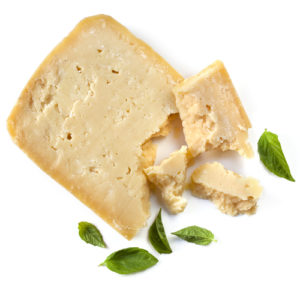
The Latest Thoughts on Cheese
Up until the 1980s, there was a general belief that all dairy products, including cheese, were good for us. In the 1990s, we were told by the experts that eating too much saturated fat was detrimental to good health. Most cheeses have a relatively high saturated fat content. Thus, it was thought cheese was a major contributing factor to the body producing high levels of ‘bad’ cholesterol, which in turn increased the risk of heart disease. However, according to the latest research, it would seem the experts of the past had got it wrong. New studies show that for the majority of people, diet has very little effect on the cholesterol content of their blood. Thus, cheese is once again being heralded as a highly nutritious and healthy food.
Vitamins and Minerals

High-fat cheeses are a good source of CLA
Cheese is known as a great source of calcium, fat, and protein. However, most varieties also contain up to 12 important vitamins and 10 different minerals. Cheese made from the milk of 100% grass-fed animals have been found to have the highest level of nutrients. These include important nutrition such as omega-3 fatty acids and vitamin K-2. High-fat cheeses in particular e.g. cheddar, and other high-fat dairy products, have also been found to contain high levels of conjugated linoleic acid (CLA). New research suggests that CLA may help prevent obesity, fight heart disease, and have anti-inflammatory properties.
Teeth and Gut
According to several other recent studies, cheese along with other dairy products, can also help to maintain dental health. A Danish three-year study, ending in 2015, found that children with an above-average dairy consumption needed fewer fillings than those with a below-average intake.
Additionally, fermented dairy products, such as yoghurt and cheese, have been found to have clear positive effects on gut health. Conversely, it’s known that when dairy is pasteurised with high heat, the presence of some beneficial compounds such as good bacteria and enzymes, are significantly reduced.
Lactose

Parmesan has low lactose
There are those people who are sensitive to dairy since it contains lactose. Which is a sugar that can’t be digested by some because their bodies lack the enzyme to break it down. Too much lactose to those people who suffer from its intolerance can lead to digestive problems. Fortunately, there are some cheeses that are very low in lactose, e.g. parmesan. Many with a lactose intolerance condition have been found to be able to tolerate low lactose cheeses. However, some people are also allergic to casein, one of the main proteins found in milk. In such cases, a low-lactose cheese won’t help tolerance.
Saturated Fat
Most cheeses are fairly high in saturated fat, and thus, have a high-calorific value. Most varieties of cheese contain around 100 calories per ounce (28 g), which is about a 1” (25 mm ) cube. However, nutrition profiles of even common cheeses can vary quite widely. For example, mozzarella typically contains 85 calories and 6 grams of fat per ounce, while cheddar has 113 calories and 9 grams of fat per ounce. If you’re looking for relatively low-calorie cheese, part-skimmed mozzarella, Swiss cheese and feta cheese, are a few examples.
Salt
Cheeses are usually loaded with salt, which makes them quite addictive, and an issue for people with high blood pressure. For people where salt is a concern, Swiss cheese only contains about 20 milligrams per ounce. A general rule is that the harder the cheese, the greater the salt content, since more is required to complete the ageing process, However, by shopping around, you should also be able to find low-sodium varieties of most popular cheeses.
Header image credit: MaraZe/Shutterstock.com
Have you enjoyed reading this article? If so, why not look up some of our other food features and menus in our Food & Drink section, by clicking on the provided link.





